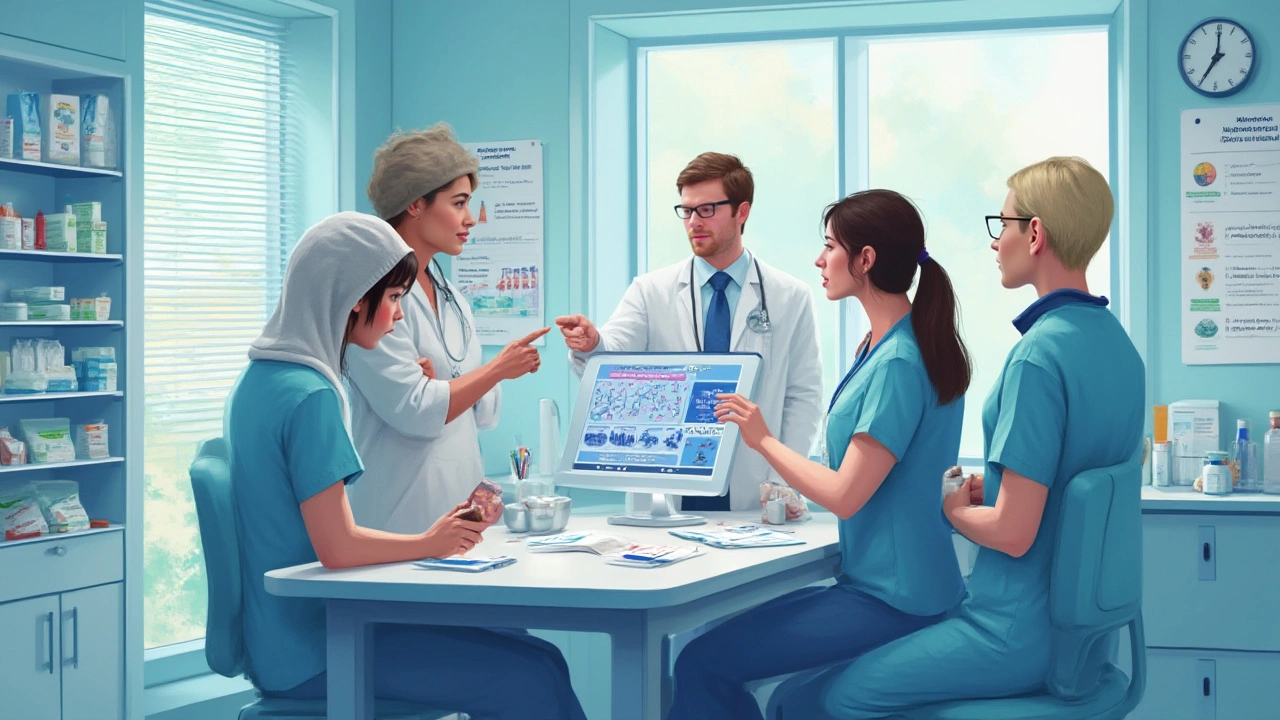Staring at a prescription for Minocin and feeling a little uncertain? You’re not the only one. Despite being around for decades, Minocin still manages to stir up confusion. It’s an antibiotic, but not your average one. This is the pill dermatologists reach for when basic acne treatments don’t cut it, and infectious disease docs call on when facing tough, resistant bugs. But what’s so special about Minocin, and why does it have a mix of die-hard fans and fierce critics? Let’s unpack what really matters when it comes to this small but mighty medicine.
How Minocin Works and Why Doctors Prescribe It
First off, let’s clear up what Minocin actually is. The generic name is minocycline, and it belongs to the tetracycline family—yep, related to classics like doxycycline and tetracycline itself. Tetracyclines have been on the market since the 1950s, but minocycline hit the scene in 1971 and came with a few upgrades. It fights bacteria by blocking their ability to make proteins. No proteins, no new bacteria, and pretty soon, the infection runs out of steam.
Doctors love Minocin for its knack at fighting a crazy wide range of bacteria. We’re talking typical skin stuff (hello, Propionibacterium acnes), but also some rather stubborn ones in the respiratory system, urinary tract, or even less usual spots. It’s often handed out for:
- Moderate to severe acne (especially when topical creams aren’t enough)
- Rosacea, if bumps and pimples are a big issue
- Respiratory infections like pneumonia, when common antibiotics fall flat
- Urethritis and pelvic inflammatory disease caused by Chlamydia or Mycoplasma
- Some rare, resistant infections, including MRSA
Unlike other antibiotics, Minocin gets into tissues quickly and stays there, which is why it’s so good for skin conditions. One fun fact: A review from 2023 noted minocycline not only clears stubborn acne but also shows promise against the growing problem of antibiotic-resistant bacteria. No wonder doctors rely on it when easy fixes don’t work!
Here’s a quick numbers check. According to recent pharmacy data (2024), about 1.2 million prescriptions for minocycline or Minocin-brand were written in the US alone last year, the vast majority for acne, followed by respiratory infections and off-label autoimmune diseases.
| Year | Minocin Prescriptions (US) |
|---|---|
| 2022 | 1,060,000 |
| 2023 | 1,170,000 |
| 2024 | 1,200,000 |
But this medicine is also famous for its ability to cross the blood-brain barrier (meaning it even gets into the brain). That’s why researchers have been looking into it as an add-on for some neurological and psychiatric conditions. Studies aren’t clear yet, but the interest is real.
Don’t be surprised if your doctor warns you about drug interactions. Don’t take iron supplements, antacids, or calcium pills close to Minocin—these can block how much of the drug your body absorbs. And don’t mix it with other antibiotics without checking. Even something innocent like a glass of milk can mess with its absorption.

Side Effects, Risks, and How to Stay Safe on Minocin
Minocin’s big claim to fame isn’t just its effectiveness—it’s also the long list of possible side effects that can trip people up. While a lot of folks sail through with nothing more annoying than mild nausea, others hit serious speed bumps. So, what should you actually expect if you’re on Minocin?
The common side effects are the sort you’d expect: upset stomach, dizziness, headaches, and increased light sensitivity. Ever notice your acne got worse—redder, more angry, maybe even a bit itchy—right after starting Minocin? Sometimes, that’s normal, especially in the first week. Stick it out, and it usually settles. But talk to your doctor if skin rashes or joint pain show up. That’s not just a minor inconvenience—it’s a reason for a check-in.
But let’s talk about the less obvious stuff. Minocin is famous for a weird side effect: it can permanently stain your teeth, gums, or even your skin. The blue-gray tint is rare, but very real, especially if you take Minocin for months at a time. Darker skin patches? Gum stains? People have reported these years after finishing the drug. For kids under eight, tooth staining is almost guaranteed, so doctors avoid it in little ones unless there’s no other option.
And then there’s this rare, but nasty, group of autoimmune-like side effects. Some people develop drug-induced lupus, which can mimic full-blown lupus (joint pain, fatigue, rashes). If you start feeling achy all over, develop new joint pain, or notice weird swelling, don’t shrug it off as usual antibiotic stuff. Minocin is also linked to something called "drug reaction with eosinophilia and systemic symptoms" (DRESS), which sounds complicated but basically means a whole-body allergic-like reaction. It’s rare, but if you get fevers, rashes, and start to feel truly rotten after a week or so, get checked immediately. Quick action makes a difference.
Here’s what often surprises people: Minocin can make you seriously dizzy, with some users describing a spinning, off-balance feeling that creeps in for hours after each pill. This happens to up to 10% of users in the first few days. Don’t plan any long drives or tricky activities at first—wait and see how it affects you. Same with photosensitivity; sunburn can hit fast, even on a cloudy day. So, stock up on sunscreen (SPF 50+) and maybe swap tanning sessions for Netflix marathons while you’re on it.
- Avoid taking Minocin while lying down—swallow it upright with a glass of water. This helps prevent irritation and rare cases of esophagus ulcers.
- Never double up on doses, even if you forget one. Take it as soon as you remember, but only if it’s not close to your next dose.
- Birth control warning: There’s a tiny chance Minocin could make your pill less effective, so consider backup protection while you’re on antibiotics just in case.
- Don’t drink alcohol heavily with Minocin—it might increase side effect risks or mess with your liver.
Liver and kidney function are on the list of things your doc watches. Long-term Minocin use (think many months for acne) can sneak up and cause problems in these organs. Bloodwork every few months isn’t overkill—it’s just playing it safe.
Check out the table below for a breakdown of side effects, how common they are, and tips to reduce your risk:
| Side Effect | How Common | Prevention Tips |
|---|---|---|
| Nausea/GI upset | Very common | Take with food, avoid heavy/fatty meals |
| Dizziness | Up to 10% | Sit down after dosing, avoid driving at first |
| Skin/teeth staining | Uncommon but possible with long-term use | Monitor, avoid prolonged use without follow-up |
| Photosensitivity (sun reaction) | Common in summer | Wear sunscreen, hats, avoid midday sun |
| Autoimmune reactions (lupus, DRESS) | Rare (<0.1%) | Report joint pain/rash/swelling fast |
| Allergy (rash, swelling) | Rare | Stop drug, seek medical help |
For anyone with allergies to tetracycline antibiotics, skip Minocin. The cross-reaction risk is not worth it. And if you’re pregnant or breastfeeding, give it a hard pass—it’s linked to birth defects and teeth problems in babies.

Tips for Taking Minocin and Making It Work for You
People love to focus on the scare stories, but there’s good news: plenty use Minocin with great results and very few problems by sticking to a few simple rules. Every medicine comes with a learning curve—here’s how to curve it in your favor and actually get the benefits.
Start by reading the label and the package insert—really. Minocin isn’t Tylenol you can take on autopilot. If your doctor writes “once daily,” don’t change it up, even if you miss a dose. For the standard acne routine, that’s usually 100 mg once or twice a day, but your script might be different for infections. Food can help nausea but can slow down absorption a bit, so ask your doctor for advice based on why you’re taking it.
Avoid taking it right before bed. The pills are notorious for getting stuck and causing burning in the throat if you dose lying down—or if you try to swallow it dry. Always chase it down with a big glass of water and stay upright for at least half an hour after. If you tend to get reflux or heartburn, Minocin can definitely make it worse. Tell your doc if swallowing hurts after starting, just to be safe.
Stick to a schedule. Consistent timing helps keep the levels of the medicine steady in your bloodstream, which makes it work better and helps your body adapt to side effects. Set a phone reminder, put sticky notes on your mirror, whatever works.
People often forget about the “what to avoid” list. Here’s a quick rundown:
- No milk, yogurt, or calcium within two hours
- No antacids or iron supplements anywhere near your dose
- Limit sun, or pile on the SPF like you’re heading to a beach in July
- Avoid alcohol if possible
If you’re on Minocin for acne, don’t expect miracles in week one. Results often show up around 4 to 6 weeks in—sometimes longer if your acne is stubborn. If you joke about your skin “purging” at first, it’s not just your imagination. Your skin may go through a rough patch before it starts looking clearer. If things go wild or you see rash, swelling, or joint pain, call your doc right away. Don’t try to ride it out or play Google doctor.
If you find yourself getting dizzy or lightheaded, grab a chair and take it easy. For most, this fades in a few days, but if you’re prone to vertigo, don’t mess around with ladders, bikes, or heavy equipment until you know how you react. Teens and young adults seem more likely to feel this “spin” sensation.
Long-term use is where people slip up: Don’t keep taking leftover pills from six months ago, even if your acne comes back. Some side effects creep in over time. That annoying blue-black coloring, for example, might not show up for months. Stick to the course your doctor recommends and go in for checkups. If you’re on Minocin for more than three months, a liver and kidney blood panel is smart. It’s just peace of mind.
One last tip: Skin-care routines and Minocin can play nice together—but ease off on heavy-duty exfoliants, acids, and peels at first. Your skin might get more sensitive while the drug is in your system, so baby it a bit. And yes, you can use topical treatments, but check with your doctor for combos that are safe.
Minocin is a classic in the world of antibiotics for a reason. Used smartly, it can be a lifesaver for tough acne and stubborn infections. Like any powerful tool, though, it pays to go in with eyes open and take it seriously. Ask questions, tune into your body, and work with your doc to make sure Minocin works—on your terms.





Aayush Shastri - 17 July 2025
Thanks for this detailed overview of Minocin! It's nice to see a balanced discussion because antibiotics can be tricky sometimes.
I've personally seen Minocin prescribed mostly for acne and some respiratory infections back home in India. The way it targets bacterial cells while sparing human cells always fascinated me.
However, one thing to keep in mind is the importance of following the dosage instructions. Skipping doses or not completing the full course can lead to antibiotic resistance, which is a growing problem worldwide.
Also, I've heard some people experience stomach upset or light sensitivity when on this med – is that something that usually passes quickly?
Overall, learning about both benefits and risks helps everyone use these medicines more safely.
Dilip Parmanand - 18 July 2025
Hey Aayush, you bring up good points about antibiotic resistance—so important to spread that message!
I appreciate the concise tips here. Just want to emphasize: do not self-medicate! Always consult with a healthcare professional before starting Minocin or any antibiotic.
That said, Minocin can be powerful if used correctly. I've personally recommended it to clients struggling with acne, and when used under doctor supervision, it works wonders.
But please watch for side effects such as nausea or skin reactions, and report anything unusual immediately.
Anyone else got some real-life experience with Minocin? Curious to hear different perspectives.
Ari Kusumo Wibowo - 18 July 2025
Honestly, I find it a bit frustrating how often antibiotics like Minocin are handed out without thorough explanation of side effects or issues like resistance.
We gotta push for better patient education. The article is a good starting point, but I hope docs actually take the time with their patients.
Also, it's crazy how light sensitivity can impact daily life; you might think it's just a rash, but it can seriously limit time outdoors.
Anyone else here who's had to modify activities due to side effects?
Anyway, good guide. Hope more people read up before popping meds.
Hannah Gorman - 18 July 2025
While the article offers a comprehensive assessment of Minocin's uses and potential side effects, I must say it falls short in addressing the intricacies of patient-specific factors that influence antibiotic efficacy and safety.
For example, renal and hepatic function, drug interactions, and individual allergic histories can drastically alter treatment outcomes.
Moreover, the long-term implications of tetracycline antibiotic use, such as Minocin, on microbiome health and antibiotic resistance patterns could have been elaborated more thoroughly.
In clinical practice, these considerations are critical when determining the appropriateness of prescribing Minocin.
I encourage readers not to oversimplify antibiotic use and to consult their healthcare providers for tailored advice.
Tatiana Akimova - 18 July 2025
Yeah, I gotta jump in here and say that no matter how solid an antibiotic seems, like Minocin, you gotta keep your eyes wide open during treatment! Don't just assume no news is good news.
I've seen quite a few cases where people ignore side effects until they get worse, sometimes unnecessarily risking their health.
Be proactive, track your symptoms, and don't hesitate to contact your doctor if things get weird.
This article is a good reminder but could have done a better job emphasizing the urgency of self-monitoring.
Who else here monitors everything meticulously while on antibiotics? It's a must in my book.
Dan Burbank - 18 July 2025
Ah, the quintessential Minocin discourse—where we delicately tiptoe between the marvels of modern medicine and the labyrinthine minefield of side effects and safety concerns.
This antibiotic, indeed a potent weapon in our pharmacological arsenal, commands respect both for its efficacy and the meticulous care required in its administration.
The article delicately balances its presentation but leaves me pondering the latent complexities of antibiotic stewardship in an age where resistance is rivaling our scientific advances.
In Canada, we've faced similar conundrums, where patient education and regulatory oversight must harmonize to avoid precipitating an antibiotic apocalypse.
Does the author or fellow readers believe current frameworks suffice in preventing misuse at the grassroots?
Anna Marie - 18 July 2025
This guide does a very good job of summarizing how Minocin should be used, but I think it’s also essential to highlight the importance of communication between patient and provider throughout the course of treatment.
Patients often hesitate to report side effects like stomach aches or skin changes, fearing judgement or that their treatment will be stopped.
Open dialogue can not only improve safety but also optimize therapy by adjusting doses or switching medications if needed.
If you experience anything unusual after starting Minocin, tell your healthcare professional right away instead of pushing through discomfort.
It's all about teamwork to get the best result!
Preeti Sharma - 19 July 2025
Isn't it strange how we all blindly trust these antibiotics, like Minocin, without questioning the deeper implications?
Sure, it kills bacteria and clears infections, but what about the philosophical cost to our body's natural order?
We treat symptoms aggressively, often ignoring the body's own resilience and healing power, potentially setting ourselves up for dependence on pharmaceuticals.
This article, while informative, still follows the conventional paradigm without challenging whether we overuse these potent drugs.
Maybe the real safety lies in wisdom, not just in facts about side effects.
Ted G - 21 July 2025
Y’all realize these antibiotics are loaded with chemicals probably meant for population control or worse, right?
Minocin might be ‘powerful’ but let’s be real: who’s watching the hidden agenda behind these drugs? Side effects? Yeah, that could be a deliberate feature.
We’re told ‘take the full course’ but what if that’s just brainwashing us to stay dependent on Big Pharma?
This guide feels way too sanitized and convenient. I’m suspicious it’s missing the larger context.
Anyone else paranoid about where this ‘safety’ info really comes from?
Miriam Bresticker - 22 July 2025
Omg this article has been super eye-opening 🤯 Minocin sounds like this crazy powerful medicine with a wild side 🩺✨
Like, I love that it tackles infections so well but the side effects? They seem kinda intense? I mean, who wants to deal with skin sensitivity or stomach troubles on top of being sick? 🥴
Also, gotta say, the tip about completing the full course is hella important — don’t wanna end up with superbugs running the show! 😱
Has anyone actually freaked out from taking it? Or like, felt vibes that they weren’t ready for? Share your stories pls ❤️🔥
Quinn S. - 22 July 2025
While I appreciate the effort to inform the public, I must point out numerous deficiencies in the article's depth and grammar.
It superficially covers Minocin's pharmacodynamics and neglects critical adverse reactions, such as phototoxicity and esophageal irritation, which should be unmistakably emphasized.
Additionally, the prose contains several grammatical errors that detract from the article's credibility and clarity.
In scientific communication, precision and rigor are non-negotiable; thus, I recommend a thorough peer review before dissemination.
This piece, as it stands, may mislead rather than educate readers adequately.